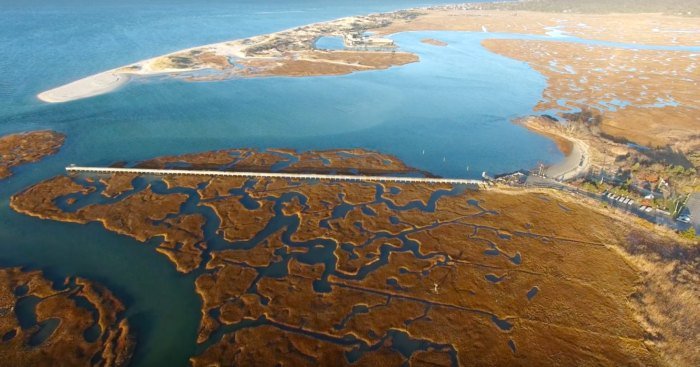The marsh and sand at the end of Center Street in Yarmouth Port has a rich and storied history.
Of course the local indigenous peoples were the first to see the area’s benefits. They probably practiced the first aquaculture in America, when they went shellfishing. Many times, they must have gathered more than they needed, and they kept the ones not used in known locations to make them easier to find the next time. Evidences of their having been in the area are common, and shell middens (piles of shells) and sometimes arrowheads, can still be seen on the Sandy Neck side. Sandy Neck was a nicer place for them than Bass Hole, for the summer winds there kept off the dreaded no-see-ums, mosquitoes, and green-heads.
The early colonials called this large area Bass Hole, evidence of nature’s bounty, but they also had two more specific names for the area. To the east of the creek was known as “Black Earth”, and it was one of three large shore whaling locations on Cape Cod in the late 17th and early 18th centuries.
Photo by Christopher Seufert
Ship building thrived on the island in the middle of Chase Garden Creek. The island, very near the present cultured clam facility was known as the “Horseshoe shipyards”, and vessels were built there after the American Revolution until the 1820s weighing up to 100 tons burthen. Further up stream, other shipbuilding enterprises thrived as well, at Bray’s shipyard, and at Hull’s and Homer’s docks.
Yarmouth had its first Town Dock right here at Bass Hole, and during the American Revolution, the British recognized this area as one of the two major ports on Cape Cod. One British map, printed in 1776, identifies only two harbors on Cape Cod: what is now Provincetown and Bass Hole. The silting in of the area in the 1820s led to moving the town wharf further west over to the Mill Creek area.
Picnicking at Gray’s Beach
To the west of the creek, a white, sandy beach stretched from the Bass Hole entrance for more than a mile southwest, all the way around to Mill Creek on the Barnstable town line. Yarmouth people called it “Gray’s Beach” before 1700. The popular beach, which included a row of bathhouses, lasted until after World War II, when a series of hurricanes in the 1950s washed away the sand. The town of Yarmouth dug the present small crescent of beach out of the marsh to recreate a bathing section for townspeople on the north side. Prior to that the town actually kept a boat at a short dock, so that anybody wanting a swim could row across to Chapin Beach in Dennis. It must have been annoying when other would-be swimmers arrived at the Yarmouth dock and hollered. You were duty bound to row back across Bass Hole to pick them up.
Mr. George Chapin had a large duck hunting camp on the Dennis side of Chase Garden Creek. It was from him that Chapin Beach was acquired by the town of Dennis and the Aquacultural Research Corporation was able to purchase its property in 1960 to begin growing clams, which it still does today.
Evidence that Gray’s Beach used to extend much further than it does today is the remains of pilings in Clay’s Creek, where the current boardwalk now ends. Thomas C. Thacher proposed in a town meeting in 1911 to use the area as a park and build a boardwalk out along the marsh that extended all the way to Gray’s Beach. Locals also used it to access the clam flats at low tide, or to go fishing off the beach, in addition to just admiring the sunset and views. Repeatedly destroyed by storms, the furthest part of the boardwalk was eventually not replaced, in part because the foot traffic was damaging the marsh and disturbing nesting terns, and so local teens were no longer able to jump off into Clay’s Creek and float back on the tide as they did into the 1970s.
Now the boardwalk has planks honoring family members and so many that have enjoyed visiting. The next time you take a stroll on the boardwalk you can appreciate the history as you take in the beautiful view.
Excerpted from articles by Duncan Oliver and Haynes Mahoney.
Aerial drone footage below by Christopher Seufert.





